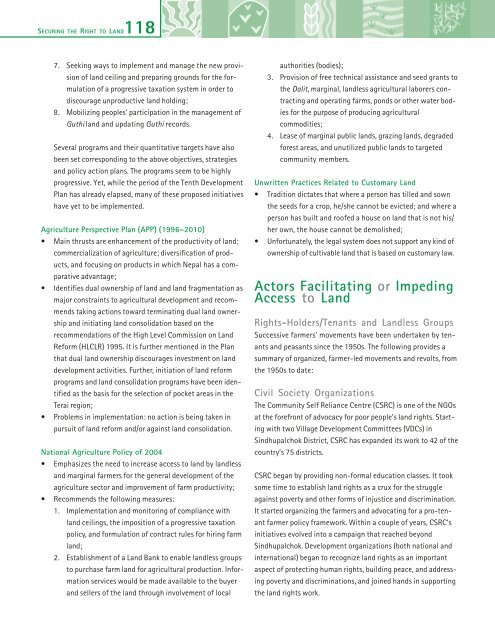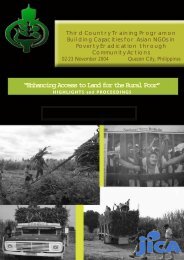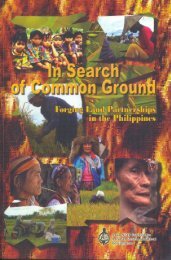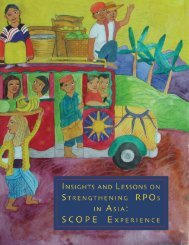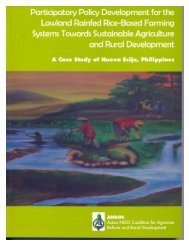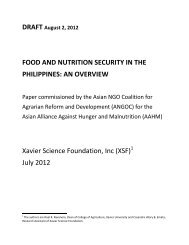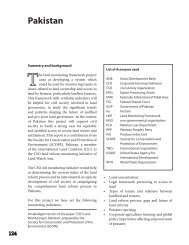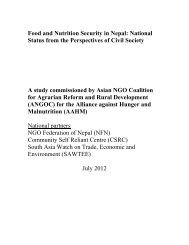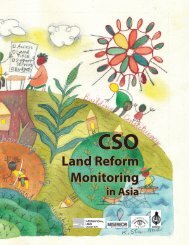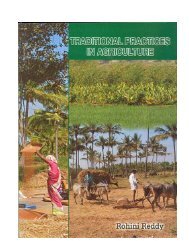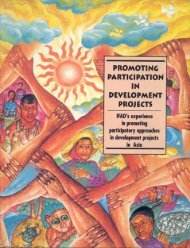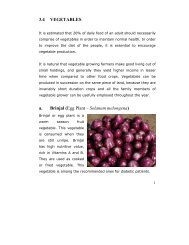Securing the Right to Land FULL - ANGOC
Securing the Right to Land FULL - ANGOC
Securing the Right to Land FULL - ANGOC
You also want an ePaper? Increase the reach of your titles
YUMPU automatically turns print PDFs into web optimized ePapers that Google loves.
SECURING THE RIGHT TO LAND118<br />
7. Seeking ways <strong>to</strong> implement and manage <strong>the</strong> new provision<br />
of land ceiling and preparing grounds for <strong>the</strong> formulation<br />
of a progressive taxation system in order <strong>to</strong><br />
discourage unproductive land holding;<br />
8. Mobilizing peoples’ participation in <strong>the</strong> management of<br />
Guthi land and updating Guthi records.<br />
Several programs and <strong>the</strong>ir quantitative targets have also<br />
been set corresponding <strong>to</strong> <strong>the</strong> above objectives, strategies<br />
and policy action plans. The programs seem <strong>to</strong> be highly<br />
progressive. Yet, while <strong>the</strong> period of <strong>the</strong> Tenth Development<br />
Plan has already elapsed, many of <strong>the</strong>se proposed initiatives<br />
have yet <strong>to</strong> be implemented.<br />
Agriculture Perspective Plan (APP) (1996–2010)<br />
Main thrusts are enhancement of <strong>the</strong> productivity of land;<br />
commercialization of agriculture; diversification of products,<br />
and focusing on products in which Nepal has a comparative<br />
advantage;<br />
Identifies dual ownership of land and land fragmentation as<br />
major constraints <strong>to</strong> agricultural development and recommends<br />
taking actions <strong>to</strong>ward terminating dual land ownership<br />
and initiating land consolidation based on <strong>the</strong><br />
recommendations of <strong>the</strong> High Level Commission on <strong>Land</strong><br />
Reform (HLCLR) 1995. It is fur<strong>the</strong>r mentioned in <strong>the</strong> Plan<br />
that dual land ownership discourages investment on land<br />
development activities. Fur<strong>the</strong>r, initiation of land reform<br />
programs and land consolidation programs have been identified<br />
as <strong>the</strong> basis for <strong>the</strong> selection of pocket areas in <strong>the</strong><br />
Terai region;<br />
Problems in implementation: no action is being taken in<br />
pursuit of land reform and/or against land consolidation.<br />
National Agriculture Policy of 2004<br />
Emphasizes <strong>the</strong> need <strong>to</strong> increase access <strong>to</strong> land by landless<br />
and marginal farmers for <strong>the</strong> general development of <strong>the</strong><br />
agriculture sec<strong>to</strong>r and improvement of farm productivity;<br />
Recommends <strong>the</strong> following measures:<br />
1. Implementation and moni<strong>to</strong>ring of compliance with<br />
land ceilings, <strong>the</strong> imposition of a progressive taxation<br />
policy, and formulation of contract rules for hiring farm<br />
land;<br />
2. Establishment of a <strong>Land</strong> Bank <strong>to</strong> enable landless groups<br />
<strong>to</strong> purchase farm land for agricultural production. Information<br />
services would be made available <strong>to</strong> <strong>the</strong> buyer<br />
and sellers of <strong>the</strong> land through involvement of local<br />
authorities (bodies);<br />
3. Provision of free technical assistance and seed grants <strong>to</strong><br />
<strong>the</strong> Dalit, marginal, landless agricultural laborers contracting<br />
and operating farms, ponds or o<strong>the</strong>r water bodies<br />
for <strong>the</strong> purpose of producing agricultural<br />
commodities;<br />
4. Lease of marginal public lands, grazing lands, degraded<br />
forest areas, and unutilized public lands <strong>to</strong> targeted<br />
community members.<br />
Unwritten Practices Related <strong>to</strong> Cus<strong>to</strong>mary <strong>Land</strong><br />
Tradition dictates that where a person has tilled and sown<br />
<strong>the</strong> seeds for a crop, he/she cannot be evicted; and where a<br />
person has built and roofed a house on land that is not his/<br />
her own, <strong>the</strong> house cannot be demolished;<br />
Unfortunately, <strong>the</strong> legal system does not support any kind of<br />
ownership of cultivable land that is based on cus<strong>to</strong>mary law.<br />
Ac<strong>to</strong>rs Facilitating or Impeding<br />
Access <strong>to</strong> <strong>Land</strong><br />
<strong>Right</strong>s-Holders/Tenants and <strong>Land</strong>less Groups<br />
Successive farmers’ movements have been undertaken by ten-<br />
ants and peasants since <strong>the</strong> 1950s. The following provides a<br />
summary of organized, farmer-led movements and revolts, from<br />
<strong>the</strong> 1950s <strong>to</strong> date:<br />
Civil Society Organizations<br />
The Community Self Reliance Centre (CSRC) is one of <strong>the</strong> NGOs<br />
at <strong>the</strong> forefront of advocacy for poor people’s land rights. Starting<br />
with two Village Development Committees (VDCs) in<br />
Sindhupalchok District, CSRC has expanded its work <strong>to</strong> 42 of <strong>the</strong><br />
country’s 75 districts.<br />
CSRC began by providing non-formal education classes. It <strong>to</strong>ok<br />
some time <strong>to</strong> establish land rights as a crux for <strong>the</strong> struggle<br />
against poverty and o<strong>the</strong>r forms of injustice and discrimination.<br />
It started organizing <strong>the</strong> farmers and advocating for a pro-tenant<br />
farmer policy framework. Within a couple of years, CSRC’s<br />
initiatives evolved in<strong>to</strong> a campaign that reached beyond<br />
Sindhupalchok. Development organizations (both national and<br />
international) began <strong>to</strong> recognize land rights as an important<br />
aspect of protecting human rights, building peace, and addressing<br />
poverty and discriminations, and joined hands in supporting<br />
<strong>the</strong> land rights work.


